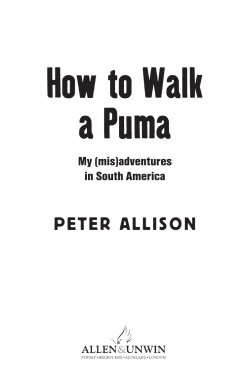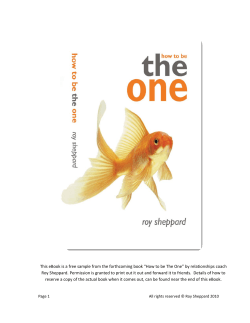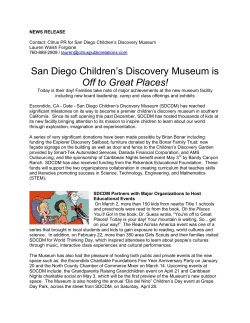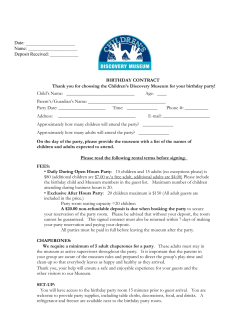
From By Anne Snowden Crosman THE ZEPHYR / DEC 2010-JAN 2011
THE ZEPHYR/ DEC 2010-JAN 2011 From “YOUNG at HEART”: Roy Rogers & Dale Evans By Anne Snowden Crosman EDITOR’S NOTE: Anne Crosman’s book of essays, “Young at Heart” was first published in 2003. Winner of the Benjamin Franklin Award and now in its third printing, we are pleased to offer this chapter about the “King and Queen of the Cowboys.” I was lucky enough to grow up with heroes like Roy Rogers and I have to admit, I had a crush on Dale when I was three. Anne interviewed them both, not long before Roy’s death in 1998. Dale died just three years later...JS Dale used to speak and perform nearly full-time. Now she’s cut back to one week a month. “I appear before religious groups,” she says. “I’ve done things for abused children, retarded children, and senior citizens. The Lord is my life, my light, and my salvation, and has been for almost 45 years, shortly after Roy and I married. I had a son Tom from a previous marriage, and Tom was a very committed, faithful Christian. He was the one who made me commit my life to Christ.” She smiles, showing movie-star perfect teeth. “I was raised in a wonderful family,” continues Roy. “But we lived way out in the country and never got to church very much. So I didn’t know too much about it until I met Dale. She married me with three babies. I’d lost my first wife when the last baby was born. Dale was smart enough to know that she couldn’t handle this unless she had the help of God. I’ve got to give God credit for taking care of me and having me meet Dale.” They smile at each other. Dale Evans Born: October 31, 1912, Uvalde, TX Profession: Singer, actress, author, speaker Home: Apple Valley, CA Roy Rogers: Born: November 5, 1911, Cincinnati, OH Profession: Singer, actor, businessman Home: Apple Valley, CA “You talk about being young at heart,” says Dale. “When I do concerts, there is a blind fellow, a terrific Christian and beautifully talented man named Ken Medema. He wrote a song called ‘Lover of the Children.’ It’s a wonderful song and I sing it wherever I’m speaking....I’ll be singing that next weekend in New Orleans at a Southern Baptist Women’s banquet on aging,” she says in a lilting drawl. “You know, I wrote a book Homestretch three or four years ago. It was all about the fact that aging should be enjoyable and that we should be able to feel so much in the homestretch, from our backlog of experiences. It’s all about the spirit of being young. Age is an attitude,” she says firmly. “Not a chronological thing.” “It HURTS once in a while, too,” chimes in Roy, referring to aches and pains. They laugh together. Dale goes on, “It’s getting up in the morning and thinking, ‘What do I have to do today? What CAN I do?’ Always keeping your mind thinking and active, but also prayerful, believing in the Lord. That’s the subject of the book I’m writing now: Celebrate Tomorrow. Look toward tomorrow with anticipation instead of dread.” They sit close, side by side, on their office sofa. They finish each other’s sentences. They laugh and talk at once. After 44 years of marriage, the King of the American Cowboys and Queen of the West still appear very much in love. “I feel very fortunate to be here,” says Roy in a soft, musical drawl. “Because last year I had a real close call. Not only an aneurysm, but right after that I had four straight colds and ten days of antibiotics for each one. The last cold turned into pneumonia. At one time I couldn’t raise my hand, I was so weak.” He smiles wanly and shakes his head. Dale nods with concern. “I got so weak, I said a little prayer,” he continues. “I said, ‘Lord, if You got anything left for me to do here on earth, let me stay a while longer. If not, let’s get out of here.’ And that’s exactly how I felt.” He speaks quietly and intensely. A small, wiry man with a baby face and blue eyes, Roy looks the quintessential cowboy in Western shirt and pants, and a fawn-colored hat pushed back on his brow. Dale, also dressed in western clothes, adds quietly, “Roy prayed the night before he was operated on for the aneurysm. It was quite serious. They told me we could lose him, but they got him just in time. That’s the same operation that killed Lucille Ball. They didn’t get her in time.” Her voice is sad. During his recovery, Roy got a big boost from fan mail. Still incredulous, he explains, “There was an article in the newspaper that said I was sick and in the hospital. The first week I got 15,000 letters and 5,000 the next week. Somebody sent me a get-well card about the size of that wall.” He points to a greeting card tacked on a long wall in the hall. “Everybody in this company signed that card. I’ll show it to you later,” he says. “I read those beautiful letters and I felt that I was being bad by even THINKING about dying. Such beautiful letters that tears come to my eyes. And I read them hour after hour.” His On a hot, spring morning, I’ve driven northeast from Los Angeles to the high desert and the mountain town of Victorville, site of the Roy Rogers-Dale Evans Museum, which opened in 1976. It’s still early, but tourists are lining up outside. The museum is a history of the Cowboy Couple, filled with memorabilia, including their favorite horses Trigger and Buttermilk, mounted, in rearing positions; their rodeo and motion picture costumes, hit record albums and sheet music, comic books, even cereal boxes with their photos on them. There are several of Roy’s cars, and one stands out: a long, sleek, lemon-yellow, 1963 Lincoln Continental convertible. I find Roy surprisingly small next to Dale, who is bigger, with strawberry-blonde hair in They sit close, side by side, on their office sofa. They finish each other’s sentences. They laugh and talk at once. After 44 years of marriage, the King of the American Cowboys and Queen of the West still appear very much in love. voice is hushed. He recovered and now makes a point of taking it easy. “I don’t make personal appearances or ride in rodeos and parades anymore,” he says. “I don’t ride horses anymore. I always say my bowling ball gets heavier and my horse gets taller every year.” He chuckles. “People see those old movies and still think I’m 40 years old, but I’m not! They forget that time passes, and you’re going with it. “I’m tired out of making personal appearances,” he goes on gently. “I am not trying to promote any kind of appearance. But Dale,” he looks at her fondly, “she does her Christian work and she does a beautiful job on it. It keeps her going. If I could talk and ad lib like she does on Christianity....” He stops, a silent compliment hanging in the air. They smile at each other. “But Iwas raised on a farm and my vocabulary isn’t that big.” They both laugh. “It’s harder for me to get up and just talk about things.” a bouffant style. Both smile continuously. He wears a hearing aid whose batteries squeal from time to time, eventually causing him to swear lightly under his breath. “The most fun thing I do now is wake up!” He laughs, eyes crinkling. “No, I enjoy coming over here to the museum. The first thing in the morning, I go in there and the people come in and they are just BEAUTIFUL. I shake hands with them and they take pictures. They all have cameras. “We don’t sign autographs, because once you start, you’re there two or three hours. I quit that about six years ago.” He pauses. “I prayed about how I was going to do it. The next morning I came in that back door down there, and this little girl about 12 come up to me and said, ‘Mr. Rogers, can I get your autograph?’ He mimics a child’s shy, highpitched voice. “And I said, ‘Honey, we don’t sign autographs anymore. 30 THE ZEPHYR/ DEC 2010-JAN 2011 Roy adds, “Dale studies her Bible a lot. She knows it frontwards and backwards.” “I hope I am helping these older people,” she continues. “I just pray I am. I pray that I will be USED, that God will use me. People ask me, ‘Do you have a goal?’ I say, ‘Yes. I want to have a SERVANT heart, to serve others.’ And that’s what makes me happy—helping.” They receive a lot in return. Roy looks at a canvas in the next room and speaks with hushed awe. “That’s a painting of Dale and me and Dusty. I think that’s about the biggest one we’ve seen. A guy did that! He had to go to the trouble to make a big painting like that. They brought it in yesterday. “People send us all sorts of things. A lot of the stuff in the museum are things that people have done for us. It surprises us, that there are so many of them,” he says. Dusty returns and hands a bit of yellowed newsprint to his father. “This is what I was looking for,” says Roy excitedly. “It’s a newspaper piece called ‘The Value of a Smile.’ People always ask me about why I smile so much. I tell them, ‘It takes a lot more muscles to frown than it does to smile.’ The American Mothers and the Missouri Mothers Association sent this to me.” He gives it to me and I read aloud. “‘A smile is nature’s best antidote for discouragement. It brings rest to the weary, sunshine to those who are sad, and hope to those who are hopeless and defeated. A smile is so valuable that it can’t be bought, begged, borrowed, or taken away against your will.’” We shake hands with mom and dad and we try to find out where you are from and we take pictures....’ ‘Oh!’ she said. ‘You take pictures?’ “And that settled it,” says Roy, beaming. “She was very happy that we took a picture with her and her mother and father. And I’ve been doing that ever since. Every morning I go out there and take pictures till we get ’em ALL taken care of, and talk to them. It really perks you up for the day.” He smiles gently. “And real thrilling things happen for me,” he goes on. “I’ve had men 60 years old, tears running off the end of their cheeks. They become five years old all of a sudden! And a lot of ladies the same way. “Yeah, they remember you when they were kids, and I guessI impressed them. Sometimes those things grow with you all your life.” He stops, lost in thought. On a hot, spring morning, I’ve driven northeast from Los Angeles to the high desert and the mountain town of Victorville, site of the Roy Rogers-Dale Evans Museum, which opened in 1976. It’s still early, but tourists are lining up outside. “A lot of people look at me and say that they can’t believe I am 80 years old. A guy asked how it felt to be 80 years old, and I said that I didn’t know, ’cause I just GOT that way!” He grins. “But I guess I’m very fortunate, even though I’ve had some rough things happen with my heart situation. “Whatever I got left, I’d like to be UP and not be in bed.” He is vehement. “I’d rather be dead than laying in bed someplace the rest of my life.” Roy has been diagnosed with congestive heart disease, a condition that sobers him. “I don’t want to push it. I’ve had two heart operations in the last few years, and this aneurysm just last year. I take it day by day. I suppose whatever I’m supposed to have, I will ride it out and do what comes naturally, just living another day. “I have so much to be thankful for,” he goes on. “I saw my mom and dad getting physically older and how they aged and the things they could do. They were a very pleasant couple,” he says sweetly. “My mom died at 76 and my dad was 89, so he did pretty good. “I’ve got a wonderful family to brace me up, to give you something to live for. As long as I can stay healthy—I’m not the healthiest guy in the world, but I can still get around and try to pace myself. I sure can’t run.” He laughs. Roy moves quite easily, as I see when he gives me a tour of the museum warehouse. They revel in their large family. It’s their greatest joy: six children, 16 grandchildren, and 25 great-grandchildren. “We have so many in our family and most of them live nearby, so we have birthdays or family reunions two or three times a year,” says Roy. “We had a party a while back before Easter and 65 people were here, all relatives, and some friends from our church.” Their oldest son Roy, Jr., affectionately known as “Dusty,”walks in and introduces himself. A blond giant of a man with a wide smile and take-charge attitude, he handles public relations for the family and museum. “You know,” Dale goes on, “you talk about attitude. It’s the way you look at getting older. I mean, when I was a child, I thought that when I was 30 years old, I was going to be DEAD! To a child of six or seven, 30 seems ancient. “The only birthday I ever minded when I came to Hollywood, was when I turned 30,” she admits. “After that, it didn’t make any difference. I don’t feel any different today than I did then, except that I have learned a great deal and experienced a great deal. But I’m still the person I was at 30. “To me, life is exciting,” she says with verve. “We’re living in some perilous days, rough days, morally, spiritually, and economically. But God is ABLE and He is still on His throne. There are those that would have you not believe it.” Do you talk with God? I ask. “Oh, yes, of course,” she replies quickly. “First thing when I awake in the morning, that’s when I talk to the Lord. I talk to Him when I’m driving in my car, and at night, but not so much, because I’m tired at night. We’ll have grace at the table and pray. Christ is my best friend. I can talk with Him about things I can’t talk with anyone else about. “I’m grateful for everything, even for the sorrows that I’ve experienced in the past, because they helped me grow. Yes, ma’am,” she states emphatically, looking at me sharply. “You take a tree without storms and wind, and a tree doesn’t grow. That’s where the growth comes—they dig that root down DEEPER into the ground. And we should, too! I speak a lot to senior citizens, I mean people who are quite morose and some of them despise being old.” I go on, “‘You have to be willing to give a smile away before it can do anyone else any good. So if someone is too tired or grumpy to flash you a smile, let him have one of yours anyway. Nobody needs a smile as much as the person who has none to give.’” He nods. “To me, that’s the best description I’ve ever heard of a smile.” You smile a lot, I observe. “Yes, I do smile, HAVE to,” he replies cheerfully. “It’s ME.” Dale and Roy describe their humble backgrounds and hard times in the Great Depression of the 1930s. “I think I’m the way I am is because of the era I was raised in,” says Roy. “I was born in the early era, the greatest era this country will ever have, from the days of the button shoes, the horse and buggy, through the Depression, right up to the man on the moon and computers. I like the earlier days better,” he confides with a wink. “Honey,” he looks at me, “we didn’t have ANYTHING. I came through the Depression without anything. Everybody was in the same boat those days. I signed with Republic Pictures, starting at $75 a week. Today you can’t get somebody to mow your lawn for that.” He chuckles and Dale nods. “If you don’t have any tough times,” he goes on, “you can’t appreciate the good times and vice versa. I thank the good Lord that I was born when I was, and that I got to see some of those experiences and live through them.” Dale speaks quietly, “I remember trying to get by on $5 a week for groceries in Chicago. I was always hungry and never able to buy enough to eat. It was just pitiful along Wacker Drive, by the Chicago River. People were homeless. After the banks all closed, people were jumping out of buildings, committing suicide.” She frowns. “I had to SURVIVE.” As a teenager, Dale eloped with her first sweetheart. “I wish now I had stayed home and finished high school and takensome college courses,” she says. “Dale did go to business school,” offers Roy. “I had to quit high school to help support my family.” Things are different today. Their entertainment and business careers have made them millionaires. “I’ve tried to get everything in shape for the kids, in case anything happens to me,” says Roy. “We’ve everything split equally among the six kids and it’s all in trust. I’m ready any time the good Lord is ready for me. If he needs a cowboy up there, he’ll have to get me a short horse.” He laughs ruefully. “Death is just a door,” says Dale. “John Milton said that death is but the key that opens the palace gates to eternity. I’mnot afraid.” “I’m not afraid either,” says Roy. “I had this last experience with my heart and that’s exactly how I felt. I stayed prayed-up all the time, and if it happened, why, it happens.” He looks serene. “I had a dream not too long ago,” Dale continues. “I dreamed that I’d died. I was aware of what was going on, but I didn’t feel any pain. I felt WONDERFUL. I’m not afraid. You know, the Bible says, ‘He that fears is not made perfect in love.’ I love the Lord and I love 31 continues on next page.....
© Copyright 2025





















